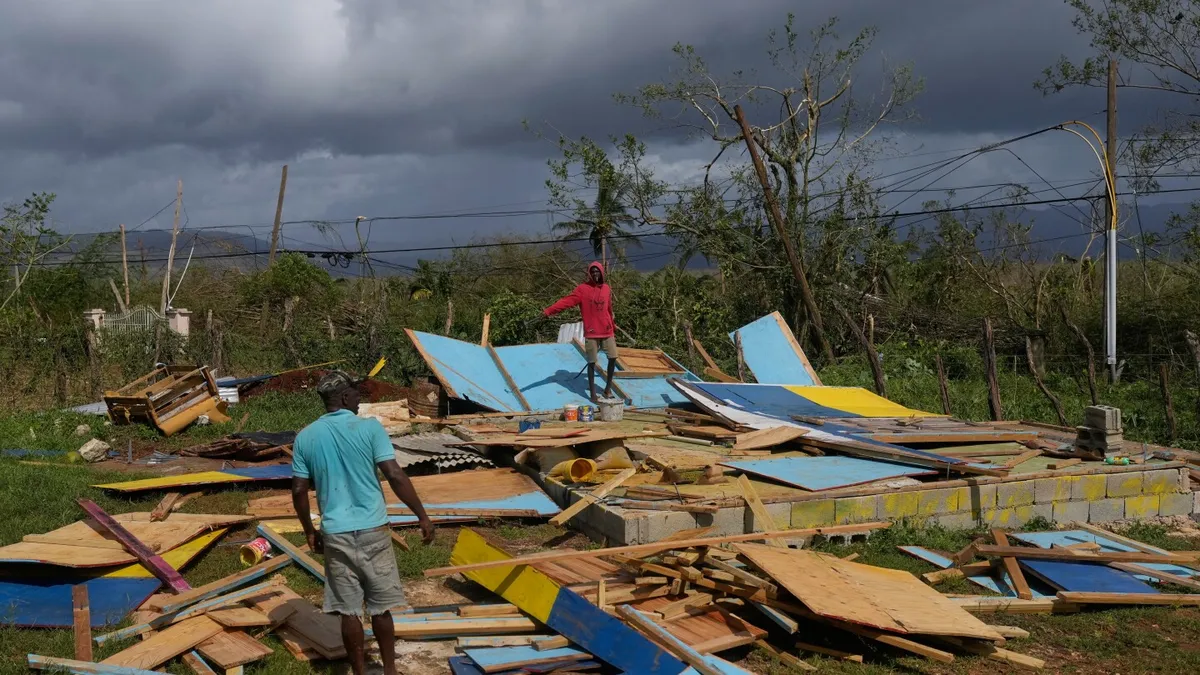
Hurricane Melissa has left a trail of devastation across Cuba, Haiti, and Jamaica, resulting in dozens of fatalities and extensive damage. As of Wednesday, the aftermath of the storm revealed roofless homes, toppled utility poles, and water-logged furniture across the affected regions. In Jamaica, a landslide blocked the main roads in Santa Cruz, located in the St. Elizabeth parish, reducing the streets to mud pits. Local residents were seen sweeping water from their homes in a desperate attempt to salvage their belongings.
The hurricane made landfall in Jamaica on Tuesday as a catastrophic Category 5 storm, boasting top winds of 185 mph (295 kph), marking it as one of the strongest Atlantic hurricanes on record. Though it weakened as it moved towards Cuba, the impacts were felt far and wide. In Haiti's southern coastal town of Petit-Goâve, flooding caused by Hurricane Melissa has tragically claimed at least 25 lives, according to the mayor, Jean Bertrand Subrème. The La Digue River overflowed, leading to the collapse of dozens of homes and trapping residents under rubble. Only one official from Haiti’s Civil Protection Agency was present to assist the community during this critical time.
In Cuba, reports indicated significant destruction, particularly in the southwest and northwest regions. As of Wednesday, approximately 735,000 people were seeking refuge in shelters. Reinaldo Charon, a resident of Santiago de Cuba, described the storm's ferocity, stating, “That was hell. All night long, it was terrible.” Many residents ventured outside, attempting to navigate the ongoing rain while assessing the damage to their homes.
In Jamaica, over 25,000 individuals had taken shelter as they faced the reality of their displaced status. Education Minister Dana Morris Dixon announced that 77% of the island was without power, making damage assessment difficult. Richard Thompson, acting director general of Jamaica's Office of Disaster Preparedness and Emergency Management, highlighted the challenges posed by total communication blackouts in several areas. Prime Minister Andrew Holness assured the public that recovery efforts were underway, stating, “Recovery will take time, but the government is fully mobilized.”
In Black River, Jamaica, Mayor Richard Solomon described the situation as “catastrophic,” emphasizing the destruction of the local rescue infrastructure, which hindered emergency operations. In the aftermath, David Muschette, an 84-year-old resident, sat among the rubble of his roofless home, lamenting his loss and pleading for help. The Jamaican government plans to reopen airports as early as Thursday to expedite the distribution of emergency relief supplies.
The United States is contributing to recovery efforts by dispatching rescue and response teams to the Caribbean. Secretary of State Marco Rubio confirmed that coordination was taking place with leaders in Jamaica, Haiti, the Dominican Republic, and the Bahamas. Additionally, the UK government has pledged $3.3 million in humanitarian funding to Jamaica for essential supplies, including shelter kits, water filters, and blankets.
In Cuba, residents began clearing debris from their homes in the eastern province of Santiago de Cuba shortly after Hurricane Melissa's landfall. Fisherman Alexis Ramos reflected on the damage, stating, “Repairing this costs money, a lot of money.” The Juan Bruno Zayas Clinical Hospital suffered extensive damage, with glass scattered across the floor and waiting rooms in disarray. Governor Yanetsy Terry Gutiérrez reported that parts of Granma province, especially the municipal capital of Jiguaní, were submerged, with over 15 inches (40 centimeters) of rain recorded in Charco Redondo.
The hurricane has the potential to exacerbate Cuba's existing economic crisis, which is already characterized by prolonged power outages and shortages of fuel and food. Cuban President Miguel Díaz-Canel addressed the nation, stressing the need for awareness regarding the strength of Hurricane Melissa and the extensive work ahead for recovery efforts.
As of Wednesday afternoon, Hurricane Melissa had weakened to top sustained winds of 100 mph (155 kph) and was moving northeast at 14 mph (22 kph), according to the U.S. National Hurricane Center in Miami. The storm was positioned approximately 150 miles (245 kilometers) south of the central Bahamas, with forecasters warning that it was growing in size. Melissa’s winds now extend nearly 200 miles (320 kilometers) from its center, and it is expected to generate up to 7 feet (2 meters) of storm surge in the southeastern Bahamas.
Before making landfall, Hurricane Melissa was linked to seven fatalities: three in Jamaica, three in Haiti, and one in the Dominican Republic. As the storm continues to impact the region, communities remain in urgent need of support, and recovery efforts are just beginning.